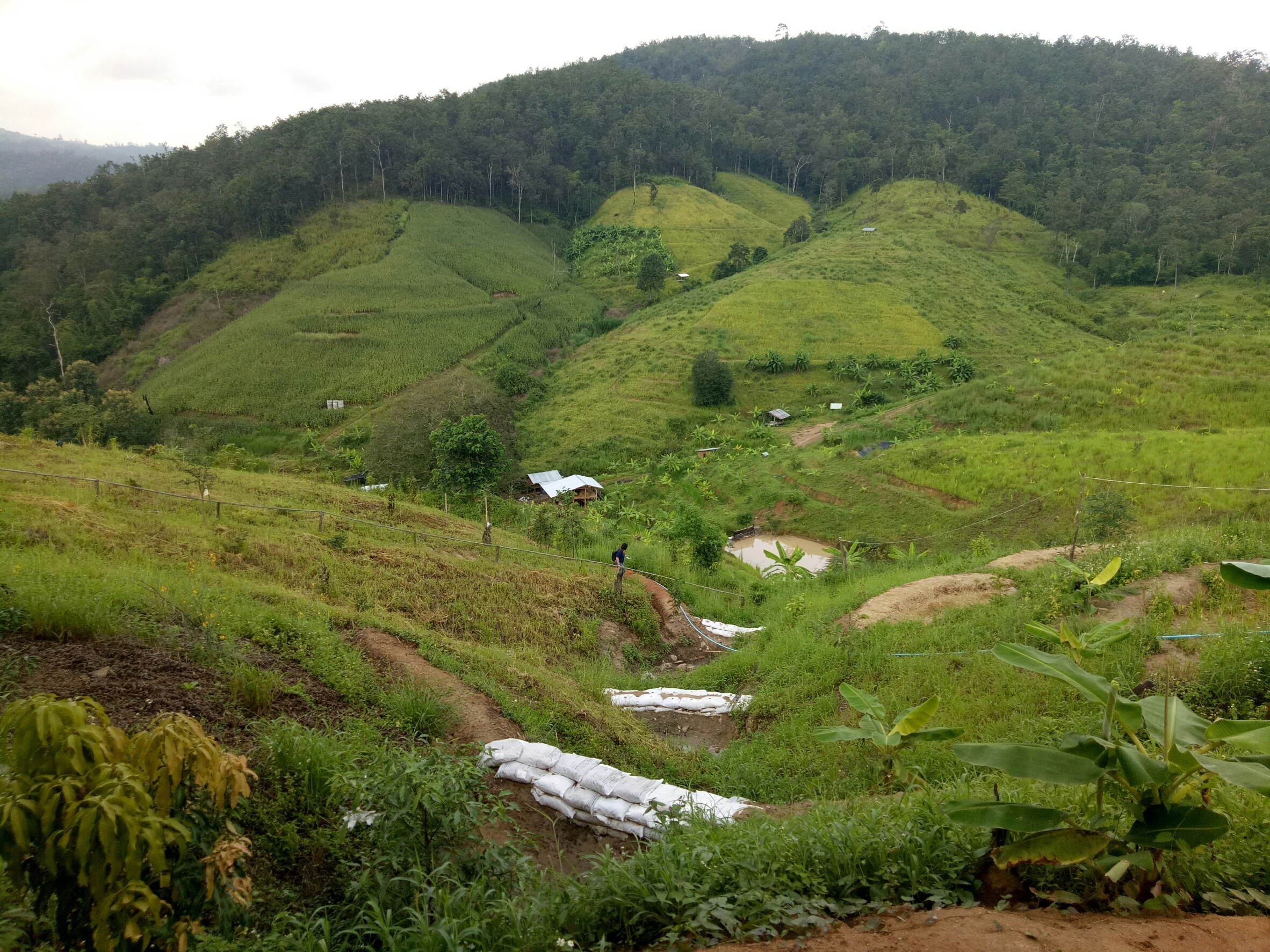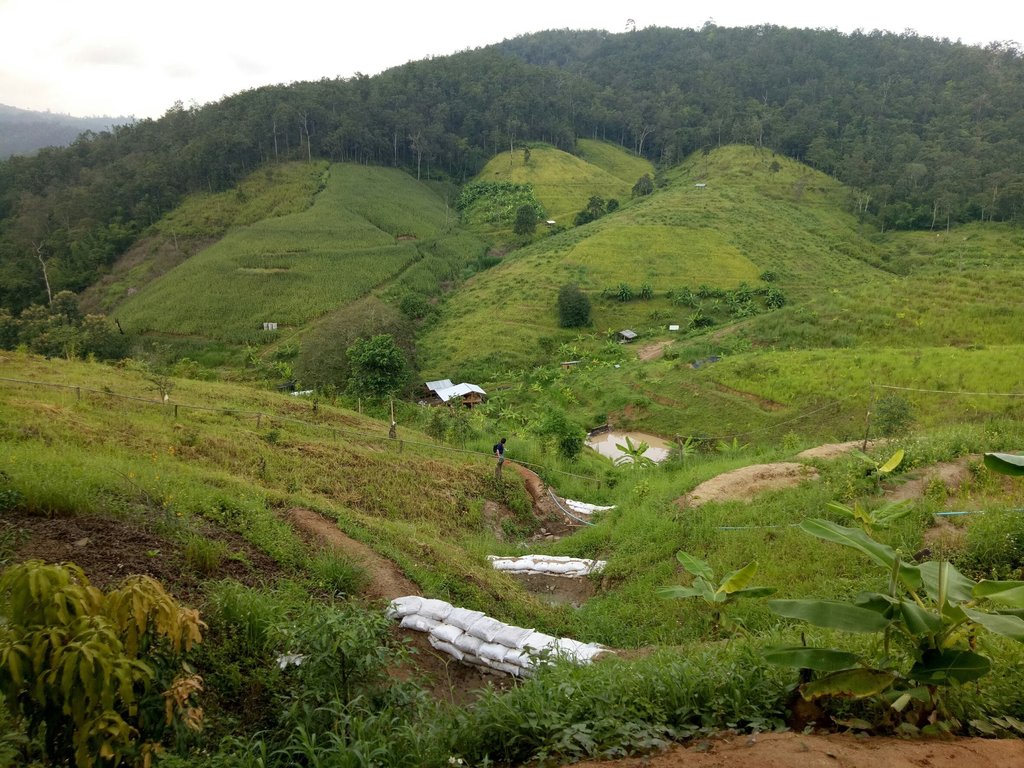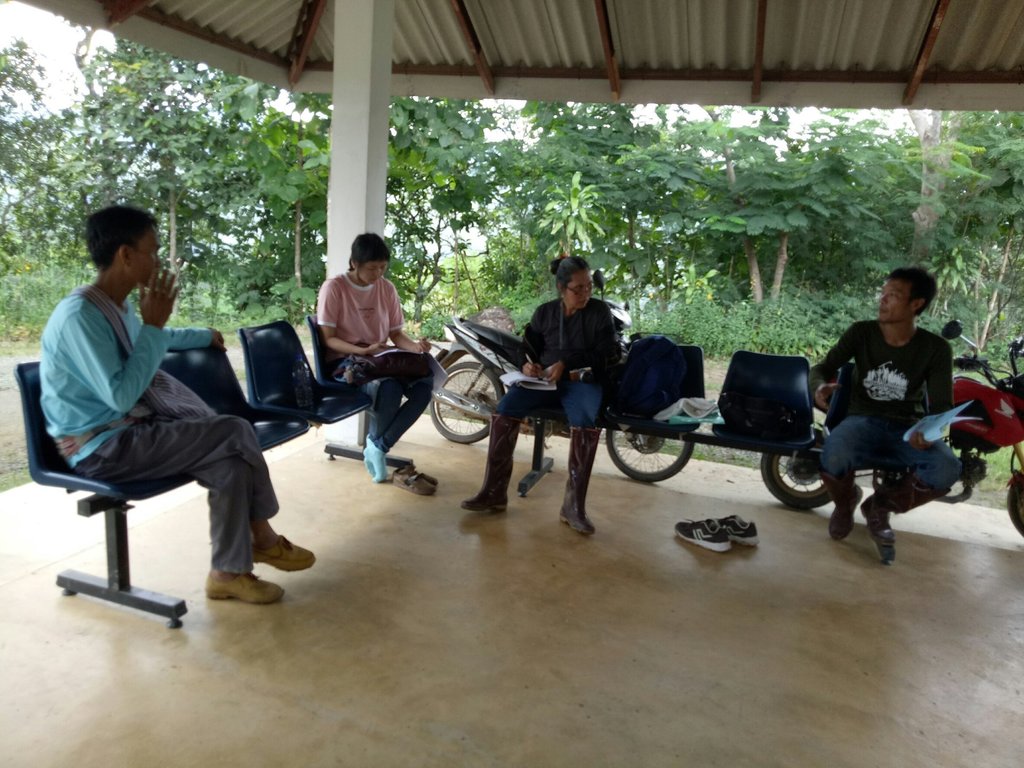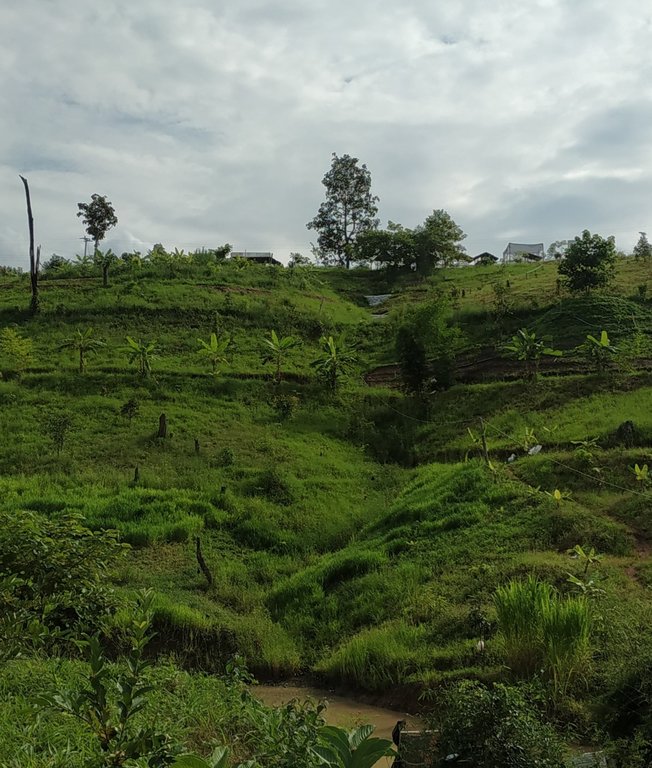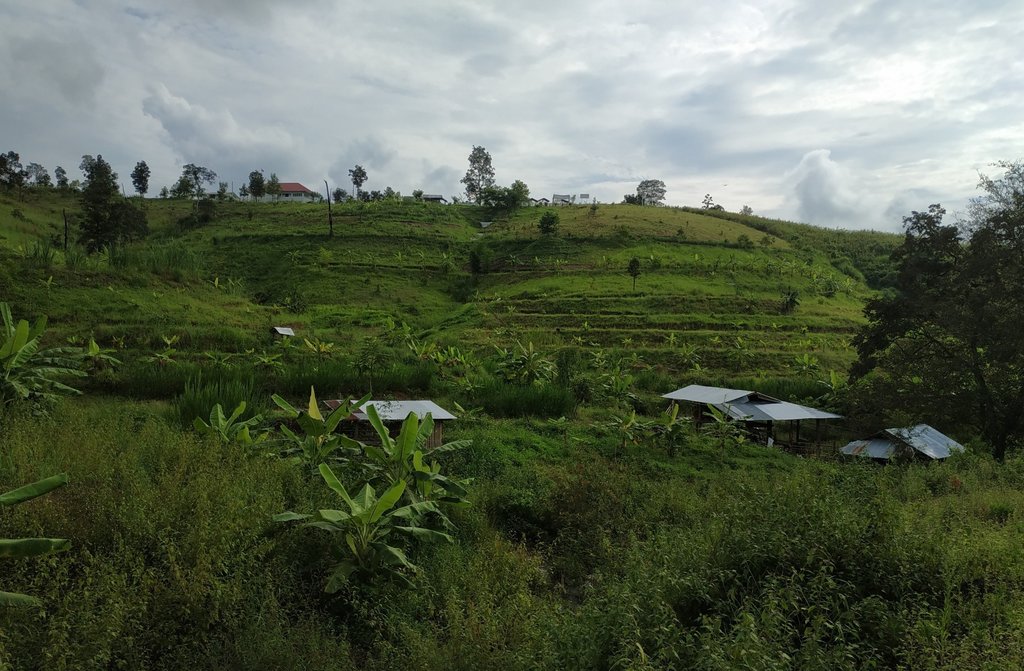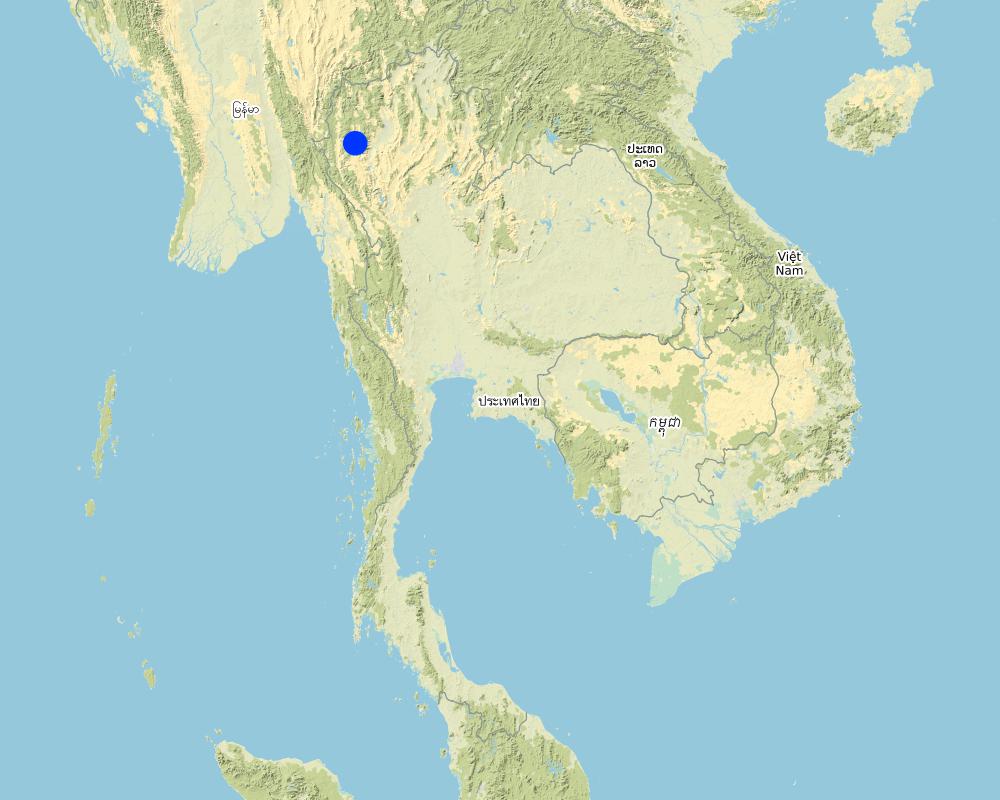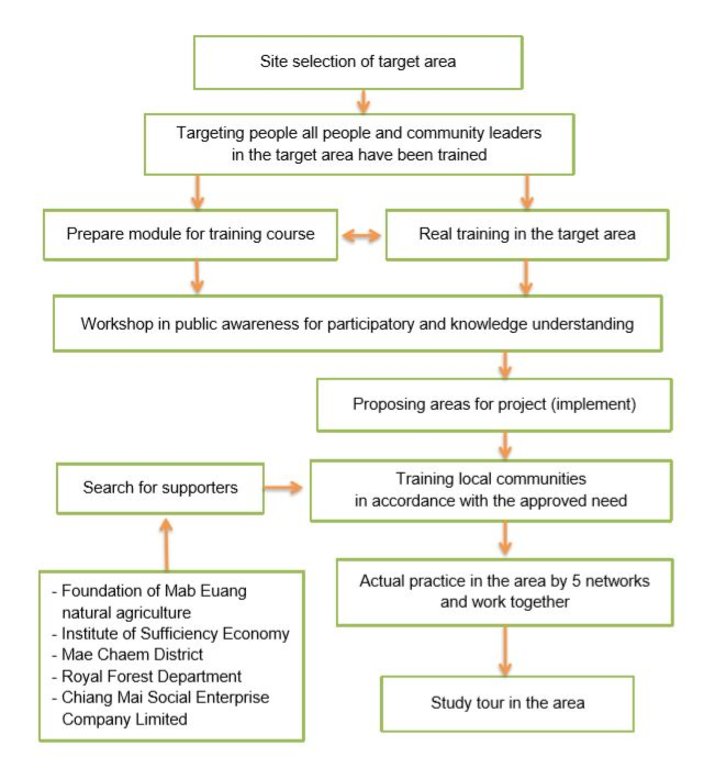Returning Life to Mae Chaem Watershed by Integrated Land and Water Management [泰国]
- 创建:
- 更新:
- 编制者: Pitayakon Limtong
- 编辑者: –
- 审查者: Rima Mekdaschi Studer, William Critchley
Integrated land and water management in landscape of Khok-Nong-Na model
approaches_4280 - 泰国
查看章节
全部展开 全部收起1. 一般信息
1.2 参与方法评估和文件编制的资源人员和机构的联系方式
co-compiler:
co-compiler:
1.3 关于使用通过WOCAT记录的数据的条件
(现场)数据是什么时候汇编的?:
12/09/2018
编制者和关键资源人员接受有关使用通过WOCAT记录数据的条件。:
是
2. SLM方法的描述
2.1 该方法的简要说明
The promotion of a model that supports sustainable cultivation outside the protected forest area in the northern highlands of Thailand. The model is based on the knowledge of King Bhumibol Adulyadej (King Rama 9). It is a prototype model of the Institute of Sufficiency Economy and the Foundation for Natural Agriculture, and uses the New Theory Approach in Agriculture to build a self-sufficiency economy.
2.2 该方法的详细说明
该方法的详细说明:
This is the approach that supports "returning life" to the Mae Chaem area by an integrated land and water management system in the highlands, through the King Rama 9 initiative combined with local wisdom: or the "Khok-Nong-Na model". Most of this area is in Mae Chaem Reserved National Forest, an upstream watershed which is strictly preserved as forest and does not officially allow people to live and cultivate. However, communities have been earning their living there for a long time before the reserved forest law was announced, which deprived them of the right to own the land and use it for agriculture. Previously all land users earned income by encroaching into Mae Chaem National Forest Reserve - and converting it into maize, shallot and cabbage fields. The forest area was intruded upon, making the soil erode, and therefore soil fertility and productivity decreased. The integrated water management system by King Rama 9’s initiative together with local wisdom, is a prototype model at the Sufficiency Economy Institute and the Natural Agriculture Foundation, supporting the “New Theory of Agriculture” based on a self-sufficiency economy. The Foundation has explained to all land users that this concept called "Khok-Nong-Na" divides the area into 30:30:30:10 portions as follows; 30% for water sources (farm ponds, small water channels), 30% for rice fields, 30% for trees, and 10% for housing and animals. Implementation of Khok-Nong-Na models will depend on the topography of the area are as follow:
1. Upland or "mound" (Khok) is the highland area as part of the mountain or hill to cultivate "three kinds of trees” as forests, namely "three forests, four benefits". “Three kinds of forests” means for consumption, construction and economy, while the fourth benefit is to preserve the ecosystem.
2. Reservoir (Nong), the lowland area as part of water resources, includes the checkdam or weir, the sediment trap, the water channel and the pond, for both consumption and agricultural use. The checkdam or weir in the upper area serves as a storage and to control the flow rate of water. The water channel is designed to deliver water to the pond or reservoir in the lower area.
3. Paddy field (Na) is an important component for rice cultivation because rice is the main staple. Rice terraces are established in the sloping area, with paddy fields in the lowland. The main purpose of rice production is for the farmer family’s consumption - as well as for income. The ridges around the rice terraces field should be high and wide to store greater amounts of water - as the water level in the paddy field can control weeds, accelerate plant growth and improve crop yields. The native rice variety grown in rich soil is immune to diseases and insects.
2.3 该方法的照片
2.4 该方法的视频
日期:
12/09/2018
2.5 采用该方法的国家/地区/地点
国家:
泰国
区域/州/省:
Ban Thap Sub-district, Mae Chaem District, Chiang Mai Province
有关地点的进一步说明:
Ban Thap Sub-district, Mae Chaem District
Map
×2.6 该方法的开始和终止日期
注明开始年份:
2015
若不知道准确的年份,请注明该方法的大致开始日期。:
不到10年前(最近)
注释:
Almost land users faced problem about debt from the investment loan for their agricultural and other activities.
2.7 方法的类型
- 基于项目/方案
2.8 该方法的主要目的/目标
The integrated land management of Khok-Nong-Na model "returns life to the watershed" by protecting the ecosystem and simultaneously promoting sustainable and productive farming.
2.9 推动或妨碍实施本办法所适用的技术的条件
财务资源和服务的可用性/可得性
- 阻碍
They should stop borrowing money as they cannot find money to clear their debts.
参与者的的协作/协调
- 启动
Almost all land users help each other and collaborate to work together around twice a week.
工作量、人力资源可用性
- 阻碍
They have more workload in their field to do comfortably in one day and there are no labourers to hire in this area.
3. 相关利益相关者的参与和角色
3.1 该方法涉及的利益相关者及其职责
- 当地土地使用者/当地社区
Household network covers 21 members
All land users cooperate with each others
- NGO
Natural Agriculture Study Center
Support all knowledge in the New Theory for Agriculture (King Rama 9)
- 私营部门
Chiang Mai Social Enterprise Company Limited
Support seed of some crops and saplings of trees and fruit trees
- 地方政府
Royal Forest Department and Mae Chaem District Administrative Organization
Create a project to manage to obtain multiple benefits from the forest for sustainable development by King Rama 9.
3.2 当地土地使用者/当地社区参与该方法的不同阶段
| 当地土地使用者/当地社区的参与 | 指定参与人员并描述活动 | |
|---|---|---|
| 启动/动机 | 外部支持 | All land users normally face drought condition, making them unable to produce agricultural products properly, causing insufficient income and the debts of land users accumulate. |
| 计划 | 互动 | Mae Chaem District Office set up a project to return life to all land users, so they can join and work together. |
| 实施 | 互动 | Land users work together with several networks in Khok-Nong-Na model with support from the Royal Forest Department, Natural Agriculture Study Center, Mae Chaem District Office and Chiang Mai Social Enterprise Company Limited. |
| 监测/评估 | 自我动员 | Monitor, evaluate and follow up by Deputy Minister of Agriculture and Cooperatives and Natural Agriculture Study Center with local officers in the area. |
3.3 流程图(如可用)
具体说明:
Flow chart Operating procedures:
1. Site selection: the target area will be seen through 5 aspects: community, temple, school, government agency and appropriate topography, with 5 strong network sectors as: government, academic, private, civil social and mass media for sustainability and expansion of civil state
2. Targeting people: all people and community leaders in the target area have been trained at the Mab-Euang Natural Agriculture Foundation.
3. Training course: the main content is agricultural development to the sufficiency economy system by the Natural Agriculture Network. This is to take 5 days and 4 nights, consisting of application of New Theory of Agriculture in the concept of sufficiency economy combined with local wisdom for soil and water management for agricultural area.
4. Workshop: this activity is organized for farmers to learn about participation, extension and to understand the concept of sufficiency economy system.
5. Joint activity: people and communities in the area propose to implement this project and staff of the study center will consider and, when appropriate, approve the project.
6. Finding support agencies: the Mab-Euang Natural Agriculture Center for Sufficiency Economy System, Mae Chaem District Office, Royal Forest Department and Chiang Mai Enterprise Social Enterprise Company Limited.
7. Field training: this activity is the real field training in the selected area, where land users and community members have been trained according to the concept of Khok-Nong-Na model.
8. Area improvement: the practices in the targeted area consist of 5 networks that work together in the land user’s area in the concept of Khok-Nong-Na model with trees and fruit trees in upland and rice cultivation in lowland or rice terraces in upland, including farm ponds. Moreover, this area will be the training and study site for other people in this area.
9. Study center: if this area is completely set up and all components of the Khok-Nong-Na model are installed, the site should be upgraded to be a study center in the future. Now this project has increased cooperation among agencies, i.e. Royal Irrigation Department, Land Development Department, both under the Ministry of Agriculture and Cooperatives, Ministry of Natural Resources and Environment, and Department of Local Administration, Ministry of the Interior.
作者:
Ms. Somjit Lertdisayawan
3.4 有关SLM技术选择的决策
具体说明谁有权决定选择要实施的技术:
- 主要是土地使用者,由SLM专家提供支持
解释:
All land users had been trained by several agencies, and let they decide the suitable technology to their area.
明确做出决策的依据:
- 对充分记录的SLM知识进行评估(基于证据的决策)
4. 技术支持、能力建设和知识管理
4.1 能力建设/培训
是否为土地使用者/其他利益相关者提供培训?:
是
明确受训人员:
- 土地使用者
如果相关,请说明性别、年龄、地位、种族等。:
-
培训形式:
- 农民对农民
- 示范区域
- 课程
涵盖的主题:
Agricultural development to achieve a self-sufficiency economy system.
注释:
Training course 5 days and 4 nights before accepting to join the project.
4.2 咨询服务
土地使用者有权使用咨询服务吗?:
是
指明是否提供了咨询服务:
- 在土地使用者的土地上
说明/注释:
Monitor, evaluate and follow up in the area.
4.3 机构强化(组织发展)
是否通过这种方法建立或加强了机构?:
- 是,适度
具体说明机构的强化或建立程度:
- 本地
说明机构、角色和职责、成员等。:
At present there are 21 household members in the group. There are rules and guidelines that indicate they must hold meetings and work together twice a week.
具体说明支持类型:
- 设备
提供进一步细节:
Tools to work in the area as spade, shovel, ploughs and also saplings of trees and fruit trees, and the costs for travelling, fuel and food when they work together.
4.4 监测和评估
监测和评估是该方法的一部分吗?:
是
注释:
Monitor, evaluate and follow up by Natural Agriculture Study Center and also local officers.
若是,该文件是否用于监测和评估?:
否
注释:
-
4.5 研究
研究是该方法的一部分吗?
否
5. 融资和外部物质支持
5.1 该方法中SLM组成部分的年度预算
如果不知道准确的年度预算,请给出一个范围:
- > 1,000,000
5.2 为土地使用者提供财政/物质支援
土地使用者是否获得实施该技术的财政/物质支持?:
是
如果是,请具体说明支持的类型、条件和提供者:
Agricultural equipment for land users to set up Khok-Nong-Na model such as spade, shovel, plough and also saplings of soil, trees and fruit trees by the Deputy Minister of Agriculture and Cooperatives, and Natural Agriculture Study Center.
5.3 对特定投入的补贴(包括劳动力)
- 设备
| 具体说明哪些投入得到了补贴 | 程度如何 | 对补贴做出具体说明 |
|---|---|---|
| 工具 | 部分融资 | Material and equipment for farming |
- 农业
| 具体说明哪些投入得到了补贴 | 程度如何 | 对补贴做出具体说明 |
|---|---|---|
| 种子 | 部分融资 | Seed of crops and saplings of trees and fruit trees |
如果土地使用者的劳动力是一项重要的投入,那么是不是:
- 自愿
注释:
The community network cooperative work together in their land.
5.4 信用
是否根据SLM活动的方法给予信用值?:
否
5.5 其它激励或手段
是否有其他激励措施或工具用于促进SLM技术的实施?:
是
6. 影响分析和结论性陈述
6.1 方法的影响
该方法是否提高了土地使用者实施土地管理的知识和能力?:
- 否
- 是,很少
- 是,中等
- 是,支持力度很大
All land users are trained to set up the Khok-Nong-Na model.
该方法是否改善了阻碍SLM技术实施的土地使用权/用户权问题?:
- 否
- 是,很少
- 是,中等
- 是,支持力度很大
该方法是否带来了更可持续的能源使用?:
- 否
- 是,很少
- 是,中等
- 是,支持力度很大
6.2 土地使用者实施SLM的主要动机
- 减少土地退化
This system can prevent soil erosion and store water in soil and farm pond
- 降低灾害风险
All land users can use their land for agricultural activities in the dry season
- 加入运动/项目/团体/网络
Participation and training program encourage land users to joint the community network
- 环境意识
This system can increase biodiversity in this area
6.3 方法活动的可持续性
土地使用者能否维持通过该方法实施的措施(无外部支持的情况下)?:
- 不确定
若否或不确定,请具体说明并予以注释:
All land users need to understand this model and government sector necessary to support in the early stage of development because they do not have enough budget to start this activity by themselves. Moreover, they have no bargaining power in finance, income and the market.
6.4 该方法的长处/优点
| 土地使用者眼中的长处/优势/机会 |
|---|
| Improve and restore natural resources, i.e. environment, soil, water, and forest . |
| This system would save labor, fuel and material cost of pumping water into the fields for fruit trees and various crops. |
| The network members are harmonious and work together under the regulations and rules. |
| 编制者或其他关键资源人员认为的长处/优势/机会 |
|---|
| Many official and private agencies cooperate to work with strong network and community, so land users will use their land for agricultural activities and at the same time they would help in reforestation. |
| This model will discourage all land users to do their slash-and-burn practice. |
6.5 该方法的弱点/缺点以及克服它们的方法
| 土地使用者认为的弱点/缺点/风险 | 如何克服它们? |
|---|---|
| Farmers have more work load per day to do it comfortably. | That is good to improve their soil and increase their products and income. |
| They have not yet started to earn money at this time and have no ability to reduce their debts. | They would like the government to help with their debts. |
| 编制者或其他关键资源人员认为的弱点/缺点/风险 | 如何克服它们? |
|---|---|
| At the first stage they cannot produce agricultural products because they do not have enough water. | Local officers should recommend some short-period plants to generate income. |
| This area has organic and green vegetable market in schools and hospitals nearby but farmers cannot produce sufficiently to serve the demand of that market. | This model should serve to help store more water in their area, to be sufficient for agricultural production. |
7. 参考和链接
7.1 方法/信息来源
- 实地考察、实地调查
- 与土地使用者的访谈
2
- 根据报告和其他现有文档进行编译
Ban Thap Subdistrict Administrative Organization
7.2 参考可用出版物
标题、作者、年份、ISBN:
=
可以从哪里获得?成本如何?
=
7.3 链接到网络上可用的相关信息
标题/说明:
Man changes the world SS4 TAPE 28: Mae Chaam model plus (9 Jul 18) 1/3
URL:
https://www.youtube.com/watch?v=k7Bex9ku_qY&feature
标题/说明:
Man changes the world SS4 TAPE 28: Mae Chaam model plus (9 Jul 18) 2/3
URL:
https://www.youtube.com/watch?v=RwY01nOLVvs&feature
标题/说明:
Man changes the world SS4 TAPE 28: Mae Chaam model plus (9 Jul 18) 3/3
URL:
https://www.youtube.com/watch?v=doiZ8r6Bo9I&feature
链接和模块
全部展开 全部收起链接
无链接
模块
无模块


